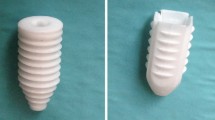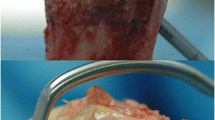Abstract
The endoscopic single incision technique for anterior cruciate ligament (ACL) reconstruction with a femoral half-tunnel may lead to a graft/tunnel mismatch and subsequent protrusion of the block from the tibial tunnel. The typical tibial fixation with an interference screw is not possible in these cases. Fixation with staples in a bony groove inferior to the tunnel outlet can be used as an alternative technique. Current literature does not provide biomechanical data of either fixation technique in a human model. This study was performed to evaluate the primary biomechanical parameters of this technique compared with a standard interference screw fixation of the block. Fifty-five fresh-frozen relatively young (mean age 44 years) human cadaver knee joints were used. Grafts were harvested from the patellar tendon midportion with bone blocks of 25 mm length and 9 mm width. A 10-mm tibial tunnel was drilled from the anteromedial cortex to the center of the tibial insertion of the ACL. Three different sizes of interference screws (7 × 30, 9 × 20, 9 × 30 mm) were chosen as a standard control procedure (n = 40). For tibial bone-block fixation the graft was placed through the tunnel, and the screw was then inserted on the cancellous or the cortical surface, respectively. Fifteen knees were treated by staple fixation. A groove was created inferior to the tunnel outlet with a chisel. The bone block was fixed in this groove with two barbed stainless steel staples. Tensile testing in both groups was carried out under an axial load parallel to the tibial tunnel in a Zwick testing machine with a velocity of 1 mm/s. Dislocation of the graft and stiffness were calculated at 175 N load. Maximum load to failure using interference screws varied between 506 and 758 N. Load to failure using staples was 588 N. Dislocation of the graft ranged between 3.8 and 4.7 mm for interference screw fixation and was 4.7 mm for staples. Stiffness calculated at 175 N load was significantly higher in staple fixation. With either fixation technique, the recorded failure loads were sufficient to withstand the graft loads which are to be expected during the rehabilitation period. Staple fixation of the bone block outside of the tunnel resulted in a fixation strength comparable to interference screw fixation.
Similar content being viewed by others
Author information
Authors and Affiliations
Additional information
Received: 2 September 1996 Accepted: 30 January 1997
Rights and permissions
About this article
Cite this article
Gerich, T., Cassim, A., Lattermann, C. et al. Pullout strength of tibial graft fixation in anterior cruciate ligament replacement with a patellar tendon graft: interference screw versus staple fixation in human knees. Knee Surgery 5, 84–88 (1997). https://doi.org/10.1007/s001670050032
Published:
Issue Date:
DOI: https://doi.org/10.1007/s001670050032




